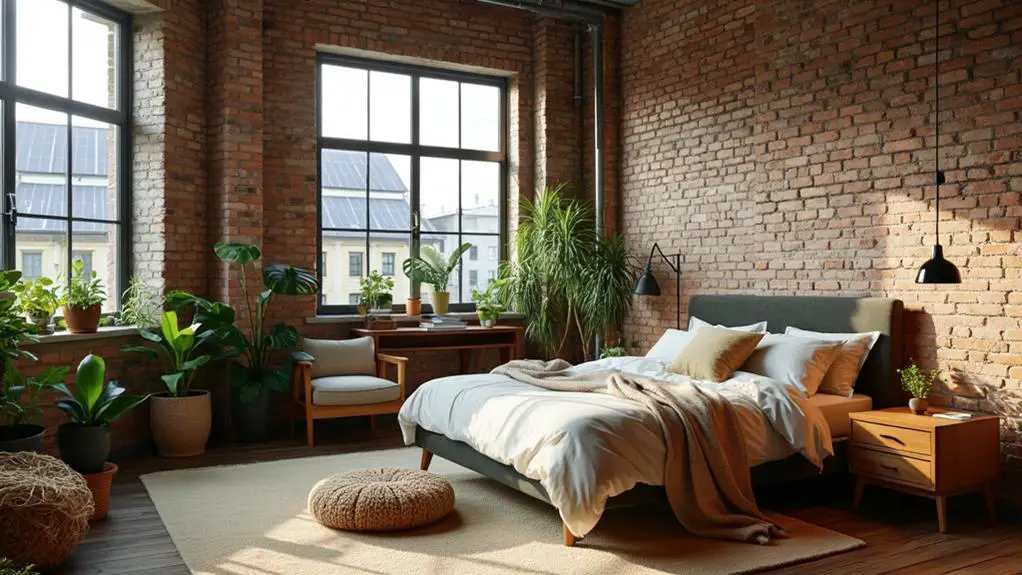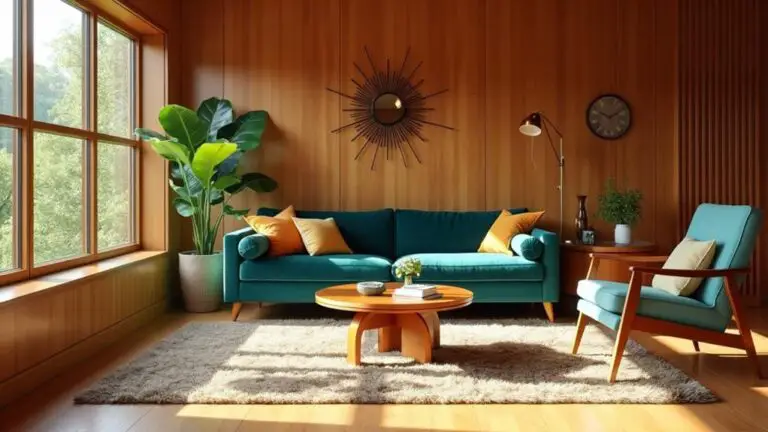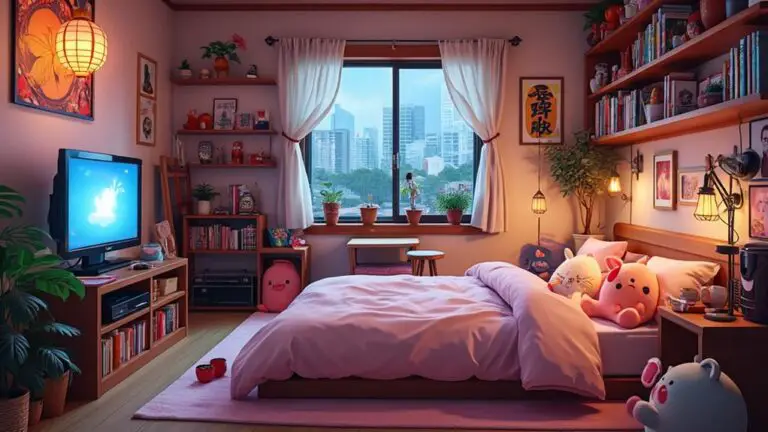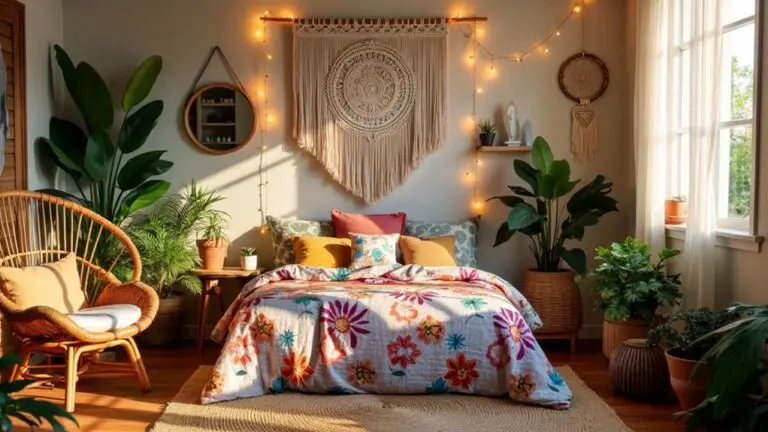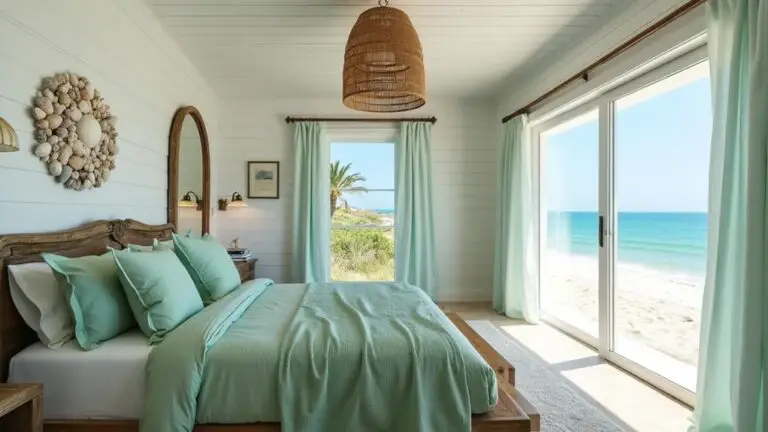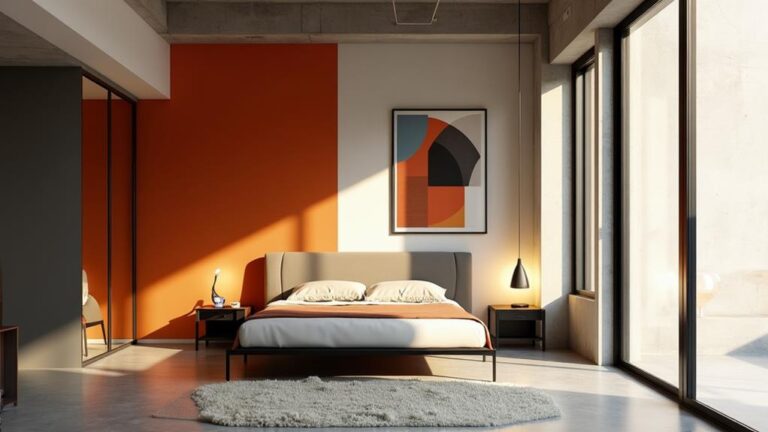Eco-Industrial: Sustainable Urban Loft Room Makeovers
I've transformed numerous urban lofts into eco-industrial havens, blending sustainability with style. By embracing open space design, I create fluid living environments that maximize natural light and airflow. I incorporate industrial aesthetics using exposed bricks and reclaimed materials, reducing waste and carbon footprint. Strategic furniture placement and lighting define functional zones while maintaining openness. I integrate tropical indoor gardens to improve air quality and add lush greenery. Sustainable furniture selections and energy-efficient LED lighting complete the eco-friendly ambiance. With personalized touches and proper maintenance, these lofts become unique, environmentally conscious spaces. There's so much more to explore in sustainable urban living.
What To Know
- Integrate open space design principles to maximize natural light and create flexible living areas.
- Incorporate industrial aesthetics with exposed bricks and reclaimed materials for a sustainable, visually appealing backdrop.
- Use functional zoning strategies with strategic furniture placement and lighting to define spaces while maintaining openness.
- Add tropical indoor gardens to improve air quality and create a lush environment within the industrial setting.
- Select sustainable furniture made from reclaimed materials to reduce waste and enhance the eco-industrial aesthetic.
Open Space Design Principles
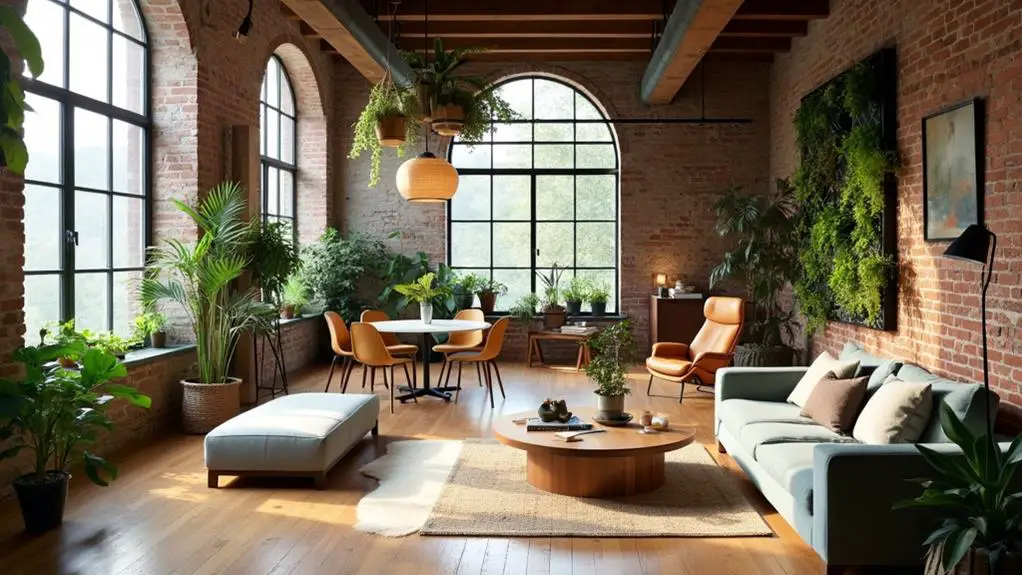
Open space design principles are revolutionizing urban loft makeovers.
I've seen firsthand how removing walls and partitions creates a fluid living environment that maximizes natural light and airflow. This approach not only contributes to energy efficiency but also allows for flexible use of interior space.
I've found that residents can easily adapt their living areas to various activities, which is essential in smaller urban lofts. By creating a cohesive and expansive environment, I've incorporated features like tropical indoor gardens, enhancing both aesthetics and air quality.
The emphasis on natural light in open spaces reduces reliance on artificial lighting, supporting sustainability goals.
I've effectively zoned different areas using furniture placement and lighting, maintaining an airy feel while delineating spaces for living, dining, and gardening activities.
Industrial Aesthetics and Materials
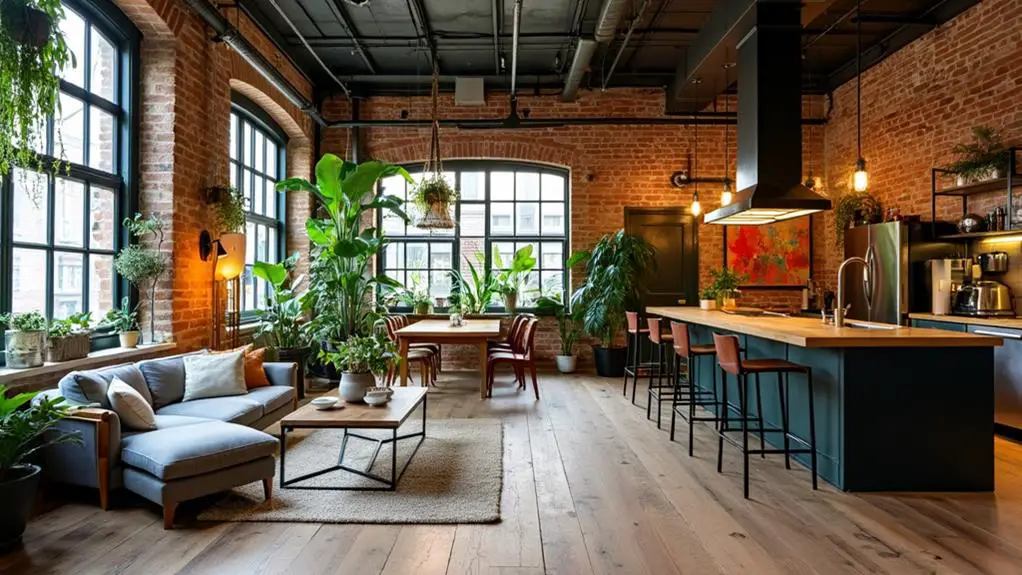
How does industrial aesthetics enhance sustainable urban loft makeovers? I'm convinced that industrial aesthetics play an important role in creating eco-friendly urban spaces.
By incorporating raw elements like exposed bricks and concrete floors, I create a neutral backdrop that's perfect for integrating natural materials and greenery.
I love using reclaimed wood and metal fixtures, which not only add character but also reduce waste and our carbon footprint.
Large windows and high ceilings are essential in my designs, maximizing natural light and improving energy efficiency.
I'm particularly fond of the dynamic contrast between rugged industrial elements and soft, organic furnishings.
To complete the look, I always opt for eco-friendly finishes like low-VOC paints, ensuring healthier indoor air quality.
Industrial aesthetics aren't just visually appealing; they're a sustainable choice for urban living.
Functional Zoning Strategies
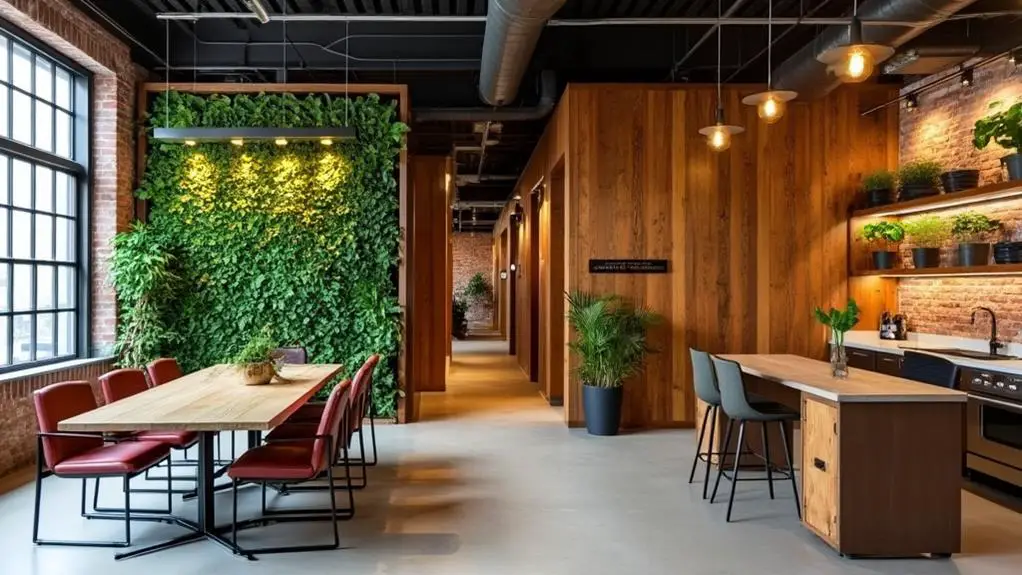
Within sustainable urban loft makeovers, functional zoning strategies play an essential role in maximizing space efficiency and livability. I've found that strategic furniture placement is key to creating distinct areas while maintaining an open feel. I use area rugs to define separate zones, enhancing aesthetics and providing visual cues for different activities. Creative lighting solutions help me delineate functional areas, with pendant lights and floor lamps establishing purpose in each zone.
| Zone | Furniture | Lighting |
|---|---|---|
| Living | Modular sofa | Floor lamp |
| Dining | Extendable table | Pendant light |
| Kitchen | Island with stools | Under-cabinet |
| Work | Foldable desk | Task lamp |
I incorporate multifunctional furniture, like storage ottomans, to support various activities efficiently. By maintaining a cohesive design through consistent color schemes and materials, I guarantee each area feels connected yet distinct, creating a harmonious and sustainable urban loft space.
Tropical Indoor Garden Integration
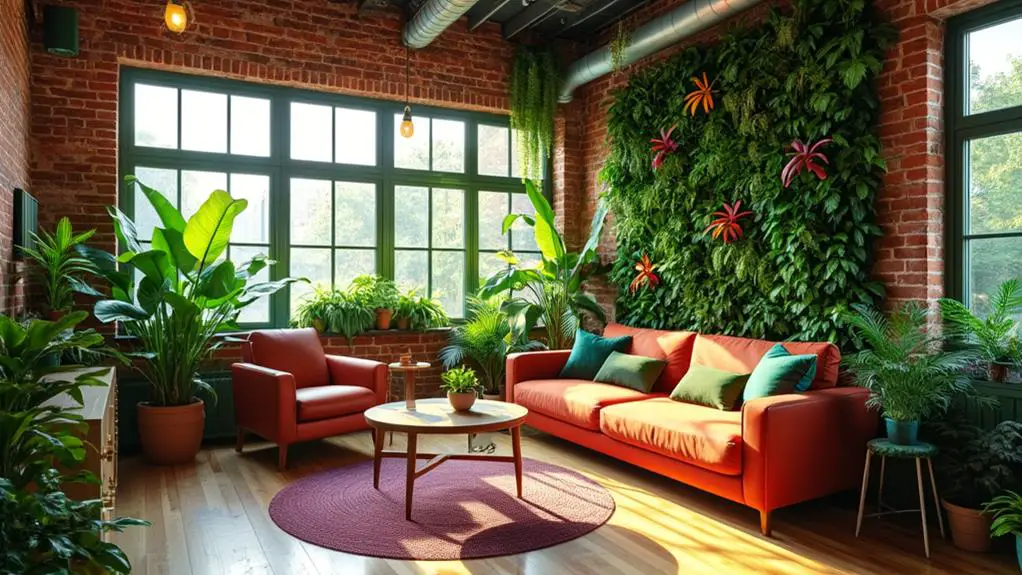
I've found that incorporating a tropical indoor garden into urban loft makeovers adds a vibrant, natural element that transforms the space. By selecting low-maintenance plants like Monstera, Palms, and Snake Plants, I can create a lush environment that thrives in various lighting conditions.
I position these plants near windows or use grow lights to guarantee ideal growth. To create visual interest, I utilize planters of different sizes and heights, complementing the loft's industrial aesthetic while adding depth to the space.
This tropical indoor garden not only enhances air quality by filtering pollutants and increasing humidity but also contributes to a rejuvenating atmosphere. Regular maintenance is key, including watering and soil monitoring.
I personalize the garden with unique planters and accessories, reflecting the resident's style while maintaining the eco-industrial theme of the loft makeover.
Sustainable Furniture Selection
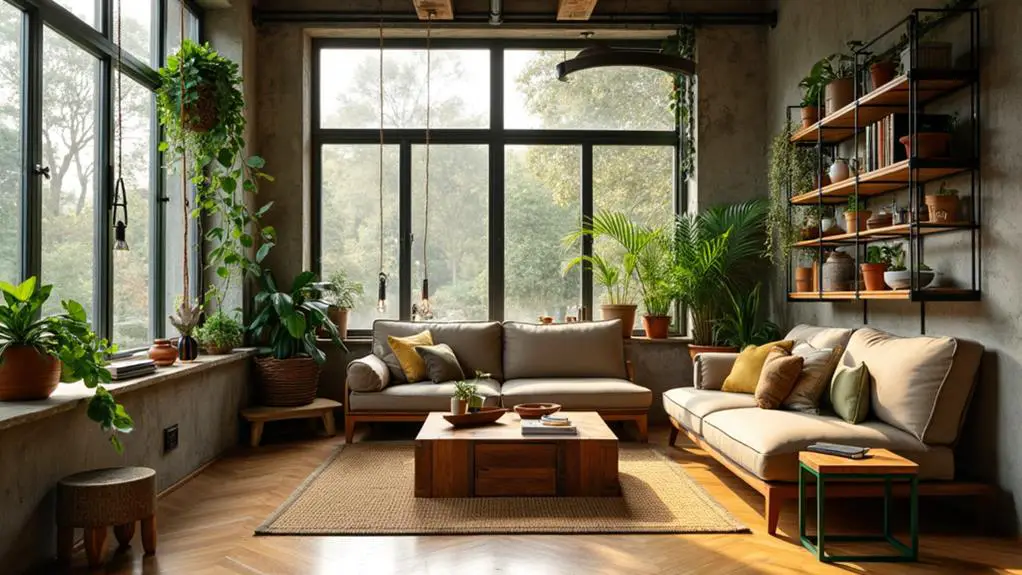
I'm excited to explore sustainable furniture options for urban lofts, starting with pieces that showcase reclaimed materials.
In my search, I've discovered stunning tables made from salvaged wood and chairs crafted from repurposed metal, each telling a unique story of sustainability.
I'm also drawn to modular eco-friendly designs that offer flexibility and longevity, allowing for easy reconfiguration as my space evolves.
Reclaimed Materials Spotlight
Treasure hunters of sustainable design, take note: reclaimed materials are the crown jewels of eco-friendly urban loft makeovers.
I've discovered that incorporating salvaged wood and repurposed metal into furniture not only reduces waste but adds unique character to my urban loft.
By choosing reclaimed materials, I'm saving 30% more energy compared to using new lumber, considerably lowering my carbon footprint.
I'm also improving my indoor air quality, as these sustainable pieces often have lower VOC emissions.
What's more, I'm supporting my local economy by sourcing from nearby deconstruction projects and sustainable mills.
The benefits are clear: reclaimed materials in urban loft design offer a perfect blend of sustainability, style, and history.
It's a win-win for both my living space and the environment.
Modular Eco-Friendly Designs
Selecting sustainable furniture for my urban loft has led me to discover the wonders of modular eco-friendly designs. I've found that these pieces prioritize sustainability by using renewable materials like bamboo and reclaimed wood, reducing environmental impact.
What's more, their multifunctional capabilities are perfect for my space-constrained loft. I can easily transform a sofa into a bed, maximizing efficiency.
I love how customizable these designs are, allowing me to choose finishes that match my style while adhering to sustainable practices. The use of low-VOC finishes and eco-friendly adhesives guarantees healthier indoor air quality, which is vital in my compact living space.
I'm particularly impressed by brands that implement responsible sourcing practices, minimizing waste and obtaining materials from sustainable sources.
These modular eco-friendly designs truly offer the perfect blend of functionality, style, and environmental consciousness for my urban loft.
Lighting for Eco-Industrial Ambiance
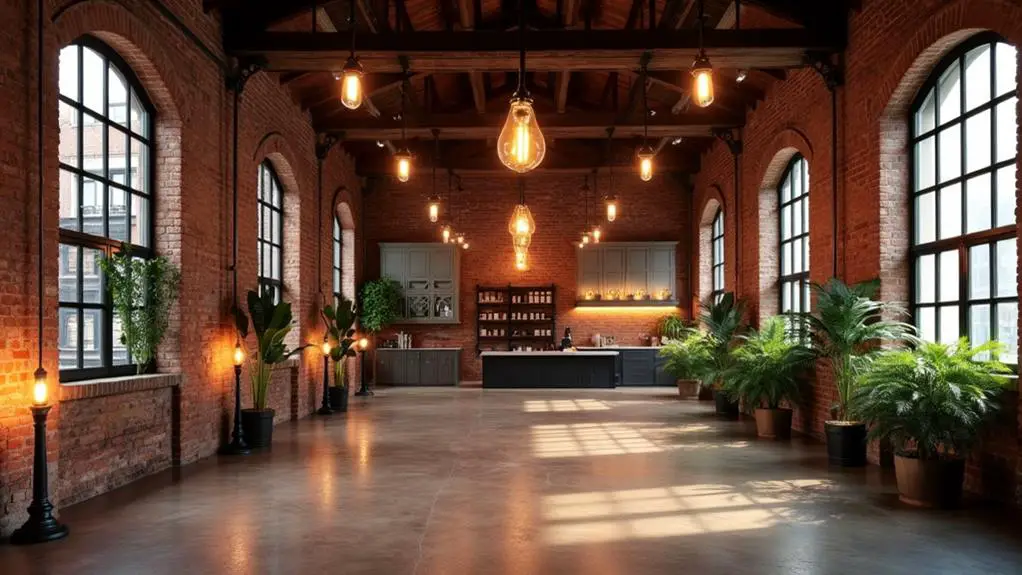
Illuminating an eco-industrial loft requires a thoughtful approach that balances style, sustainability, and functionality.
I've found that LED fixtures are a game-changer for urban loft lighting, consuming 75% less energy and lasting up to 25 times longer than traditional bulbs. To add character, I love incorporating pendant lights made from reclaimed materials, which reduce waste and enhance the eco-industrial aesthetic.
I always recommend integrating smart lighting systems, allowing remote control and optimizing energy usage. This can cut electricity bills by up to 30%.
To create depth, I layer ambient and task lighting using eco-friendly materials like bamboo or recycled metals.
Maximizing natural light is essential, so I strategically place windows and use light-reflecting surfaces. This approach decreases reliance on artificial lighting and improves overall energy efficiency in the loft.
Personalization and Maintenance Tips
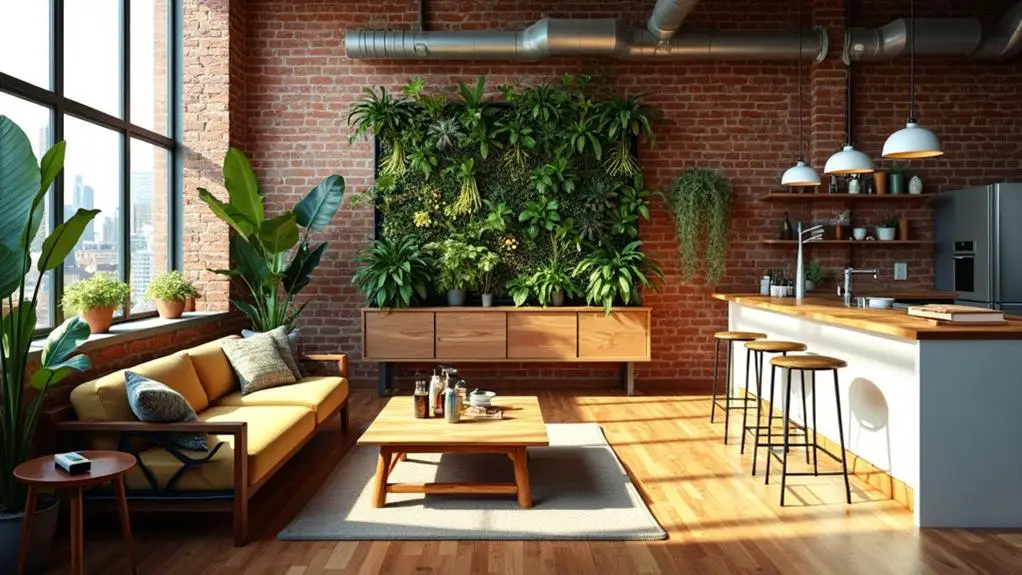
I've found that customizing my loft with upcycled elements adds a unique touch while keeping sustainability in mind.
To maintain the eco-industrial vibe, I've incorporated plant care essentials like regular humidity checks and leaf cleaning into my routine.
I've also made sustainable decor choices, opting for natural materials and low-maintenance plants that not only look great but improve my indoor air quality.
Customizing With Upcycled Elements
A myriad of upcycled elements can transform your urban loft into a personalized, eco-friendly haven. I've found that incorporating upcycled furniture, like repurposed wooden pallets for shelving or old doors turned into coffee tables, adds character and sustainability to my space.
To maintain the industrial aesthetic, I use vintage materials like reclaimed wood and metal fixtures, reducing waste and promoting sustainable design.
I love personalizing my loft with DIY projects, creating art from discarded materials and designing custom light fixtures using upcycled components. It's important to regularly maintain these elements by treating wood surfaces with eco-friendly finishes and keeping metal pieces rust-free.
I've enhanced my loft's ambiance by adding plants in upcycled planters, improving air quality and creating a calming environment. These customizations showcase my creativity and commitment to sustainability.
Plant Care Essentials
Building on the eco-friendly theme of upcycled elements, incorporating plants into your urban loft design brings life and energy to the space.
As I've discovered, mastering plant care essentials is vital for maintaining these natural elements in an environmentally sound way. I've learned to check soil moisture regularly, watering when the top inch feels dry to prevent root rot. During the growing season, I use a balanced fertilizer every 4-6 weeks to promote healthy growth.
I position my plants in areas with indirect sunlight, which is ideal for most tropical species. To boost humidity, I've added pebble-filled trays beneath planters.
Sustainable Decor Choices
Sustainable decor choices offer a wealth of opportunities to personalize your urban loft while minimizing environmental impact.
I've found that incorporating natural materials like reclaimed wood furniture and stone accessories adds warmth and texture to my space. I've also opted for eco-friendly textiles, such as organic cotton curtains, to reduce my environmental footprint.
To maintain my sustainable decor, I follow these tips:
- Clean with non-toxic products
- Rotate indoor plants for best growth
- Refresh textiles seasonally
- Repurpose items creatively
Conclusion
As I put the finishing touches on my eco-industrial loft makeover, I'm struck by a serendipitous moment. The sunlight streaming through my new skylights catches the recycled metal fixtures just as a tropical breeze rustles my indoor garden. It's as if nature and industry have found harmony in this space. I can't help but smile, knowing I've created a sustainable urban oasis that's uniquely mine. This journey's taught me that eco-conscious living can be both stylish and deeply personal.

